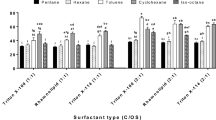Dispersion of oil-tank sludge using compositions of cationic, anionic, and nonionic surfactants followed by isolation of synthetic oil is a processing method with several disadvantages such as residual S-containing compounds and toxic spent solutions. The present work proposes the use of polycomplexants (sodium salts of iminodiacetate derivatives of fatty-acid triglycerides and mucosaccharides) as promising and affordable replacements for traditional surfactants. A methodology for processing oil-tank sludge using these compounds and results of laboratory tests showing decreased S contents and significantly lower densities and viscosities of the oil-tank sludge are given.



Similar content being viewed by others
References
L. I. Sokolov. Processing and Recycling of Oil-containing Wastes [in Russian]. Infra-Inzheneriya, (2017). p 137.
J. D. Burrington, J. K. Pudelski, and P. Roski, Challenges in Detergents and Dispersants for Engine Oil. Practical Advances in Petroleum Processing. Springer Science & Business Media (2007). 866 pp.
Y. Wang, X. Zhang, Y. Pan, et al. Int. J. Hydrogen Energy, 42, No. 29 (2017).
E. M. Anchugova, M. Yu. Markarova, and T. N. Shchemelinina, Izv. Samar. Nauchn. Tsentra, Akad. Nauk, 11, No. 1-2, 202-207 (2009).
A. Ya. Fridman, A. U. Tsivadze, A. K. Novikov. et.al., Sci. Method, 1. No. 20, 25-29 (2018).
A. L. Maksimov, A. Yu. Tsivadze, A. Ya. Fridman et al., “Dispersion of oil-tank sludges in aqueous solutions of polycomplexants and extraction of oil from them,” in: Proceedings of an International Congress and Conference of Yong Scientists “Basic Research and Applied Development of Processing and Recycling of Technogenic Wastes” Technogen-2019 [in Russian], pp 317-320.
A. Yu. Tsivadze, A. Ya. Fridman, B. P. Tumanyan. et al., Khim Tekhnol. Topl. Masel. No. 1. 78-80 (2020).
H. A. van Sprang, Advances in X-rayAnalysis, (2000). p. 42.
GOST R 53203-2008. Oil Products. Datermination of Sulfur by Energy Dispersive X-ray Fluorescence Spectrometry.
A Yu. Tsivadze, A. Ya. Fridman, A. L. Maksimov. et al., Universum: Khim. Biol., 65.No. 11. 45-50 (2019).
Acknowledgements
The work was financially supported by the RFBR in the framework of Science Project No. 18-29-24137.
Author information
Authors and Affiliations
Additional information
Translated from Khimiya i Tekhnologiya Topliv i Masel, No. 2, pp. 48 — 51, March —April, 2020.
Rights and permissions
About this article
Cite this article
Tsivadze, A.Y., Maksimov, A.L., Fridman, A.Y. et al. Processing of Oil-Tank Sludge by Hydrothermal Dispersion using polycomplexants and Amino-Acid-Salts. Chem Technol Fuels Oils 56, 199–204 (2020). https://doi.org/10.1007/s10553-020-01129-3
Published:
Issue Date:
DOI: https://doi.org/10.1007/s10553-020-01129-3



